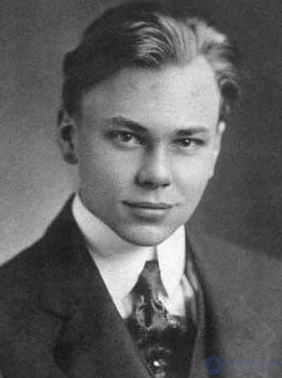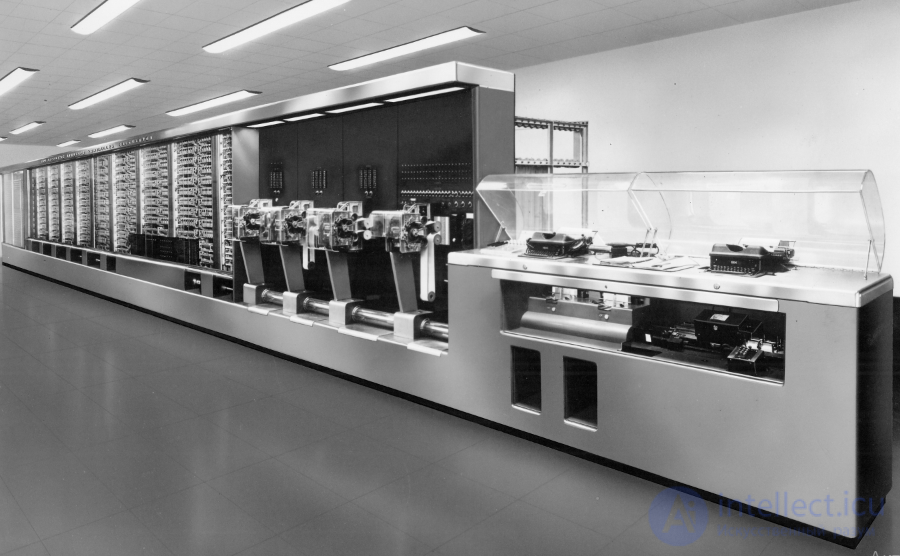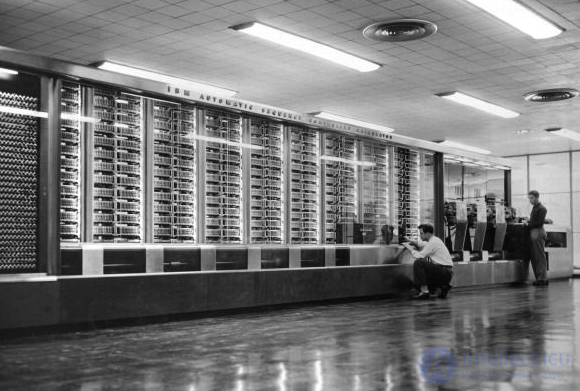Lecture
In 1864, in one of his last works, a scientist who was ahead of his time, the author of an unrealized project of the Analytical Machine, Charles Babbage, wrote: “If someone, not taught by my experience, tries to create a machine capable of performing mathematical analysis in an amount equal to the work of the whole department mathematicians, and using different principles or simpler mechanical means, and this attempt will be crowned with success, I’m not afraid to entrust such a person to such a person, since only he can fully appreciate the efforts and achieve s results. "
In reality, the ideas and concepts of C. Babbage could be realized only 80 years after the writing of these pessimistic lines. And the man who practically embodied these ideas was Howard Hetaway Aiken. However, it should be clarified that Aiken met the Babbage project only three years after starting work on creating his first child and was so amazed that he exclaimed: “Live Babbage 75 years later, I would have remained unemployed”.
Howard Aiken grew up in Indianapolis, Indiana (born March 8, 1900). After the eighth grade, he was forced to work as a night operator in a lighting and heat supply company, and in the afternoon he attended the Arsenal Technical School. The school leadership became interested in the young man’s abilities and gave him the opportunity to pass the exams ahead of time. He then enters the University of Wisconsin and at the same time works for a gas company. In 1923, Aiken received a bachelor of science degree, and for night work - the post of chief engineer of a gas company.
After working as an energy engineer for 10 years, in 1935 he enrolled at the University of Chicago and then became a graduate student in physics at Harvard University. Aiken’s Doctoral Thesis “The theory of the conductance of space charges”, presented to the physics department of Harvard University in 1939, is replete with expressions of frustration about that it was impossible to solve analytically nonlinear differential equations that adequately describe the phenomena he studied, and that their numerical solution even for several interested students Learning requires the implementation of inaccessible amount of calculations.
As a result of these reflections in 1937, his work appeared (he published it at his own expense) under the title “Offered automatic counting machine”, where the author described the machine as a switching board, on which various components of the computing machine were mounted, each panel of the switching board intended to perform certain mathematical operations.
Harvard was the center of “pure” research at that time, so Aiken did not find support, there was more resistance. Many did not believe that such a machine can be created. He was supported only by astronomer Harlow Shap-lee and Professor of the School of Business Ted Brown. Aiken tried to incorporate the Monroe firm into this work, in particular the chief engineer J. Chase. Chase became interested, but the company management found the idea impractical and refused to implement it.
Chase recommended that Aiken contact IBM - that was how he met Thomas Watson, the president of the company. In 1939, a contract was signed under which IBM, with the financial support of the US Navy, took on the creation of an Aiken machine. Seven years later, in May 1944, the car, dubbed “Mark-G, entered into operation. Relays, counters, contact devices, printing mechanisms, punch cards and punching devices used in the machine were standard parts of tabs manufactured by IBM at the time.
This machine, which worked with 23-digit decimal numbers, performed an addition operation in 0.3 seconds. and the multiplication operation for 3 seconds. and had impressive dimensions (length - 17.4 m, height - 2.5 m).

“Mark-1 was distinguished by high performance (if the term could be applied to a car) and reliability. This colossus worked 24 hours a day, seven days a week, performing mainly calculations on secret projects of the Navy. During the first three years of work on the Mark-1 computer, 19 tables of various mathematical functions (Bessel functions, Henkel functions, integral sines and cosines, etc.) were compiled. Numerous studies related to solving large systems of linear equations using a computer “Mark-1 was conducted by Vasily Leontiev, a professor at the economics department at Harvard University (later Nobel Prize winner).
It should be noted that “Mark-1” in 1944 had the features of modern computers, in particular, the division of operations execution time, while there were no conflicting situations of various devices, and subprograms were widely used in programming. Later on, devices were introduced that “provide the means to select any of several branch paths of an operation” (i.e., conditional transition operations).
In 1947, a new Mark-1 relay machine was created in Aiken's laboratory, which had an unusual feature for that time: it could work as one machine or as two separate machines, solving two different tasks at the same time. The transition from one mode to another was made using a switch. A floating point has been entered in the machine.
In recent years, Howard Aiken has been reproached for reluctantly switching from electromechanical to electronic devices when designing his computers. Or maybe cautiously, expectantly: “No, I knew that it was necessary to go this way. I didn’t want to depend on technology, I didn’t want to worry about the reliability of unfamiliar and untested components. As soon as I saw that other projects went fine and that the engineers learned how to work with the new technology, I switched to electronics. ” And this happened when he created the third and fourth versions of the machine - “Mark-I” and “Mark-IV”. In general, from the standpoint of today, looking back, it becomes clear that computers based on electronic-vacuum technology were essentially a transitional environment on the way to creating more reliable machines using relays and semiconductor technology. And Aiken in this regard can be considered a pioneer.
The beginning of the design of the electronic machine "Mark-III" is dated January 1948, and the end - 1950 year. In it, the numbers and teams were already represented in binary code and were stored on nine aluminum drums coated with a magnetic layer.
The last computer, created by G. Aiken at Harvard for the air force, Mark-IV, was completed in 1952. In contrast to the machines designed at that time based on less reliable electrostatic memory, the Mark-IV memory with random access consisted of 200 shift registers on magnetic cores. The machine also had a large memory on a magnetic drum with separate sectors for 4000 16-bit numbers and for 1000 teams. An index register and a decoding device with a special keyboard were used in the machine to record programs in algebraic expressions that are close to normal recording.
Great successes in the automation of programming belong to Grace Hopper (Rear Admiral of the US Navy), who worked with Mark machines at Harvard from 1944 to 1949. Its contribution to the creation of the first compilers (by the way, the term “compiler” was first introduced by Grace Hopper) and the first programming languages is indisputable, and her name at that time is inextricably linked with the name of Howard Aiken and his computers.
When designing the latest machine Aiken drew attention to the problems that arise in the industrial production of computers, when they cease to be the subject of laboratory research. He was well aware of the work of Claude Shannon on relay circuits, published in 1938, but in 1949 nothing was known about using Shannon's work to design electronic circuits. In 1951, Aiken, together with his colleagues, published the book “The Synthesis of Electronic Computing and Control Circuits”.
In the preface, he wrote: “In both the laboratory and the classroom, it is easy to see that the lack of adequate mathematical methods for studying the functional characteristics of electronic control circuits was the only and most serious obstacle to the rapid development of this field and for teaching students interested in this issue ". The subsequent rapid development of the theory of switching and control systems confirmed the wisdom of this observation.


Aiken was the first to introduce a course on designing digital computing devices at Harvard in the 1947/48 school year. Immediately after this, a course on digital circuit analysis was introduced that focused on the technologies used in digital computers. During his tenure, Harvard became one of the first universities to confer degrees in computer engineering.
Aiken was a talented and inspirational teacher in the best sense. Being himself strong-willed, independent, purposeful and persistent, giving maximum time to study, science, work, he expected the same from his students and colleagues, therefore, the results they achieved exceeded their own expectations. It was an extremely active person. His trail can be found in many areas of science and technology, and the latest patent was issued a year before his death, when he was 72 years old.
In the last years of his life, he worked as a consultant to Monsanto Chemical on issues related to research in the field of magnetic domains. March 14, 1973, during a trip to St. Louis, at the headquarters of the company Monsanlo, Howard Aiken died suddenly of a heart attack.
The results of his research and teaching activities are reflected in the “Works of the Computer Lab”, which he led for many years, in many journal publications and numerous reports of the Navy and the US Air Force, the Atomic Energy Commission, the telephone laboratory, the American Gas Association and other organizations. The importance of the work that carried out his many students and colleagues.
The achievements of Howard Aiken have been recognized throughout the world, as evidenced by many of the awards that he won. When the Computing Machines Committee was first established in 1946, Aiken became one of its first members, along with George Stibitz and John von Neumann.
He was a member of the American Academy of Science and Art and the Institute of Radio Engineers; Aiken was honored by the Navy for outstanding achievements and awards of the Air Force for special civil services; his alma mater, University of Wisconsin, awarded him a diploma for outstanding professional services; Belgium awarded him the Officer's Cross of the Order of the Crown; France led him to the Legion of Honor. He was awarded the honorary degree of a doctor of higher technical education in Germany in Darmstadt, in Spain - an honorary member of the High Council for Scientific Research, in Sweden - a member of the Engineering Academy.
Henry Tromp, professor of mathematics at Humbolt State University, chief expert on the history of computer technology at the Smithsonian National Museum of Technology History, wrote: “I am convinced that Aiken was one of the forerunners of the computer age. His personal qualities had a great influence on many researchers who collaborated with him from the 40s to the 50s. ”
Comments
To leave a comment
Persons
Terms: Persons